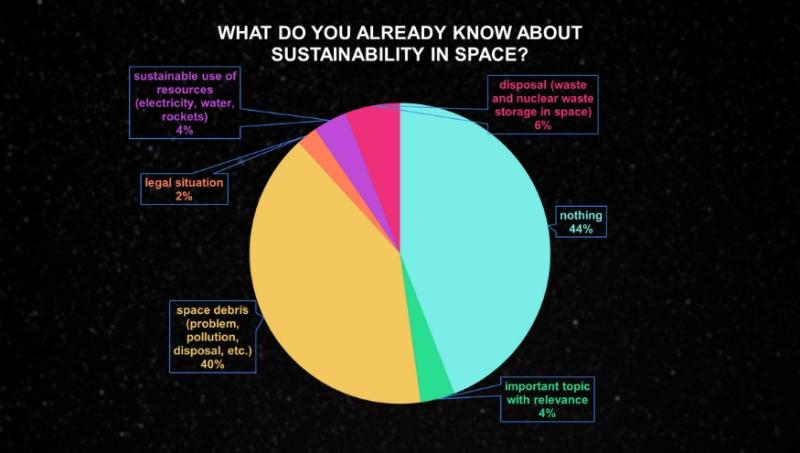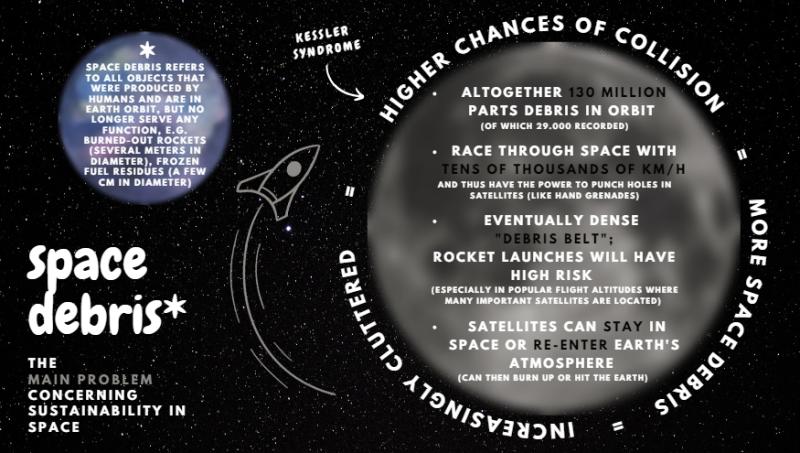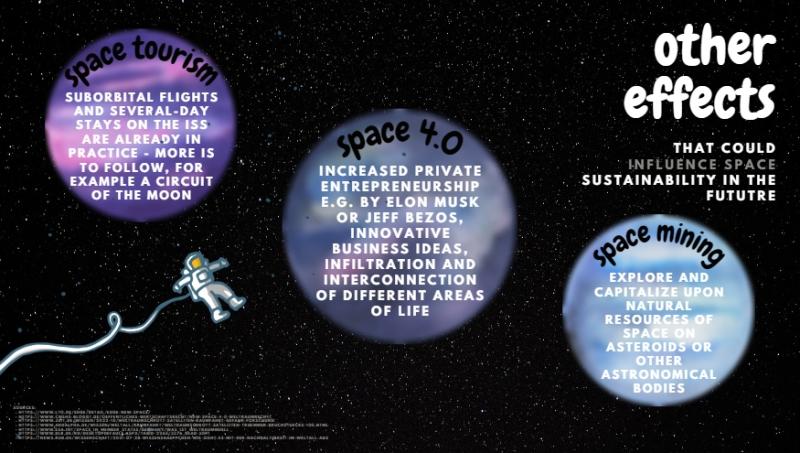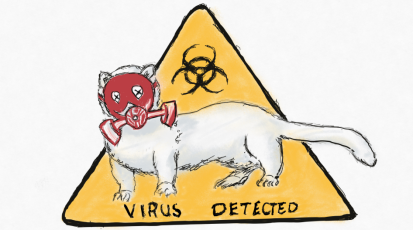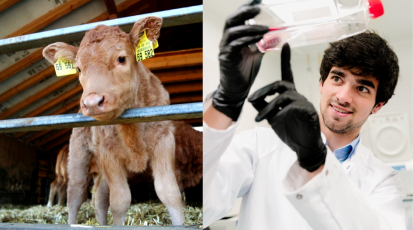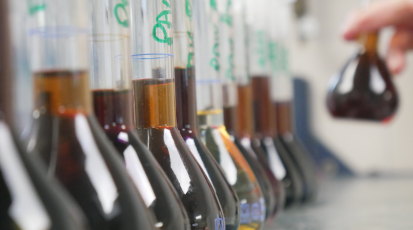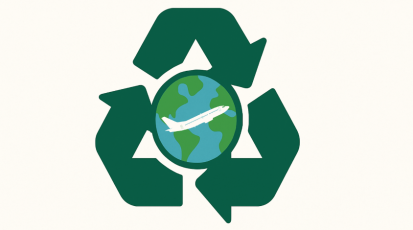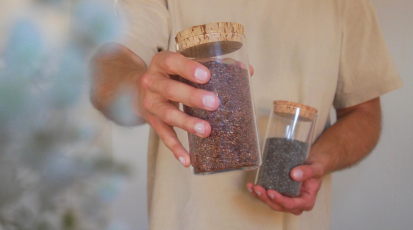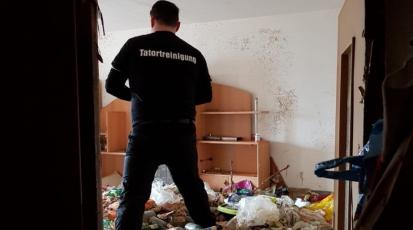Rocketing Towards Sustainability

Considering recent political events, it is obvious that sustainability on Earth is more important than ever before. However, is the situation in space even a relevant topic and if so, how does it affect us? Our team has done an online-survey with 148 people to understand the relevance of space sustainability for the people. On the one hand almost half of the participants have already dealt with the topic of sustainability in space - on the other hand, 44 percent of the respondents know nothing about the issue. 59 percent continue to claim that sustainability in space would have no impact on their lives (so far).
Small debris particles with a large effect
Contrary to popular belief, sustainability in space does have an effect on our lives. The exploration of space and the various planets has always been exciting and desirable for mankind. Exploration of the infinite realm of space started with the first rocket flights and the moon landing. The consequences: numerous new, incredible discoveries - but unfortunately an abundance of waste is left behind as well. “The mass of man-made space objects currently totals about 11000 tons”, explains Ingo Baumann, partner of one of the main space law firms in Europe. That is a bit more than the weight of the Eiffel Tower in Paris, France. Sounds quite manageable - in contrast to the waste problem on Earth. Baumann explains further: “It seems like a very small mass, but because of the special properties of space, the problem of space debris is already enormous. Some space objects stay there for decades or even centuries and orbit with an extremely high velocity.”
Therefore, every collision in space - even between two relatively small objects - creates a lot of new debris. Especially if the so-called Kessler syndrome, which was named after the scientist Donald Kessler in the 1970s, jumps into effect. This syndrome causes a catastrophic chain reaction in our orbit that will leave it unusable. Additionally, some rocket engines release chemicals into the atmosphere that can contribute to air pollution and climate change. The extensive usage and production of huge rockets and large amounts of fuel have heavy impacts on our earth as well.
According to the European Space Agency (ESA) the problem gets more and more severe as several commercial and military space players enter the limited space. “We should understand space as a resource”, says Tim Flohrer, Head of the Space Debris Office at European Space Agency (ESA).
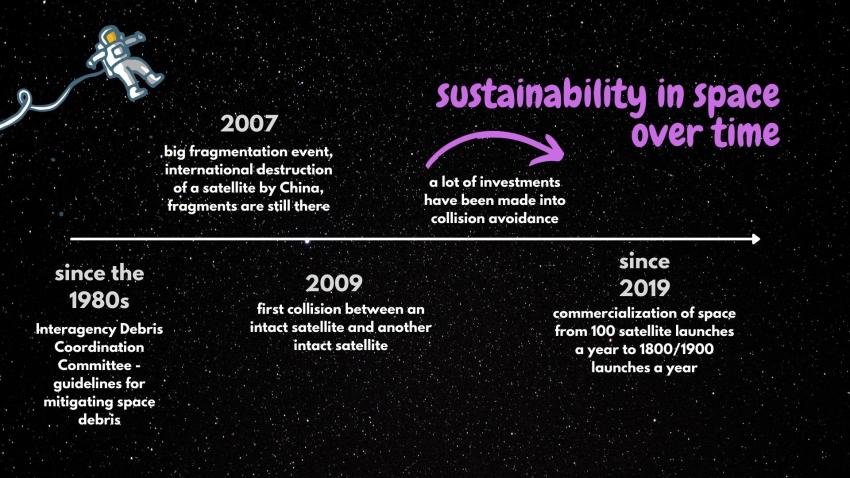
Legal guidelines
“The situation in space is the same as on Earth: If we as humans fail to solve our problems, they will come back at us and we will not succeed in the end”, says Marc Meyer, a lawyer for aviation and space law. “Space sustainability is a global problem requiring global coordination”, adds Tim Flohrer (ESA). However, how can we implement this global cooperation in a legal framework?
Solutions to ensure sustainability in space
Thus, the issue of sustainability in space is present and relevant. But what is actually being done to improve sustainability? And: What can sustainability in space even look like? “If space were used sustainably, space debris would be avoided as much as possible. This would ensure the use of space for future generations who will have increasing technological means and capabilities to explore space, for example for resources such as water and minerals that may be needed on Earth in the future”, says Grace Nacimiento, a lawyer specializing in space law.
There are steps that can be taken to minimize the environmental impact of space exploration. One solution is to develop more sustainable rocket engines that use cleaner fuels or that can be reused multiple times. Another key aspect is the use of renewable energy sources at space stations and satellites. Solar power is currently the most widely used source of renewable energy in space, with many spacecraft and satellites relying on solar panels to generate electricity. However, other renewable sources such as nuclear power, with its ability to generate electricity for long periods of time, are also being explored not only to power components like antennas or cameras, but also for propulsion in space.
ESA’s plan to tackle sustainability in space
To solve the issue of sustainability and especially space debris in space, it is important to consider short-term and long-term consequences of space activities. When looking for short-term solutions the current action plan for ESA is to follow plans of collision avoidance of satellites with space debris and other intact satellites. In the long run ESA is working on a solution to tackle sustainability with a variety of plans such as setting an example with bringing one large piece of space debris back to earth. “We develop the technologies at ESA but we are not commercial operators and we are also not the lawmakers. We just make sure that both sides, space companies and lawmakers, have technology available”, clarifies Tim Flohrer (ESA). However, active space debris removal is just one part of a larger plan to address sustainability in space.
Non toxic fuel as a solution
Commercial players like SpaceX, Spinlaunch or BluShift are working on a variety of approaches to make spaceflight profitable and sustainable at the same time. While SpaceX saves resources like metal by reusing parts of its launch vehicles, the start-up Spinlaunch is working on a giant centrifuge to literally throw satellites into orbit. This drastically reduces the fuel consumption for launches, as the rockets only need fairly little fuel for the last part of their flight. However, a lot of technical challenges still need to be solved to make the technology cheap and reliable.
BluShift, a space technology start-up from Maine in the United States of America, meanwhile is on the quest to perfectionise the usage of biofuel in rockets to launch smaller satellites into space. The market for the launch of small satellites is especially important as more and more large clusters of very small satellites are created. They can be used for monitoring the environment, tracking down pirates on earth, distributing wireless internet and lots of other tasks. From time to time, single satellites reach the end of their lifespan, are deorbited and replaced by new ones. These single, small satellites do not need large rockets like ESA’s Ariane 6, that is able to carry over 20 tons into orbit, but rather small ones. These smaller rockets can be fueled with cleaner, non-toxic fuel that is even edible and releases only a small amount of dangerous emissions into the atmosphere.
Sustainability is key
Condensed this means: Sustainability is key for the future of space exploration missions. Especially as we use a lot of technologies like navigation, weather forecasting and telecommunication on a daily basis that are dependent on functioning satellites. By minimizing the environmental impacts of space missions, we can ensure that the benefits of space exploration are realized without risking the health of our planet. “There are different paths. We can have a path that leads to a sustainable future and we can have a path that leads to a disaster and everything in between”, says Tim Flohrer (ESA).
As an individual being it is hard to bring sustainability to space. But making a change down on earth will also help to bring sustainability in space forward. Nevertheless, it is possible to invest in eco-friendlier space companies, to talk about possible issues or to start working in the industry yourself. More uplifting news are, that there are already a lot of agencies, start-ups and experts that are working on solutions and leapfrog-innovations that could further disrupt the space industry in the future.




